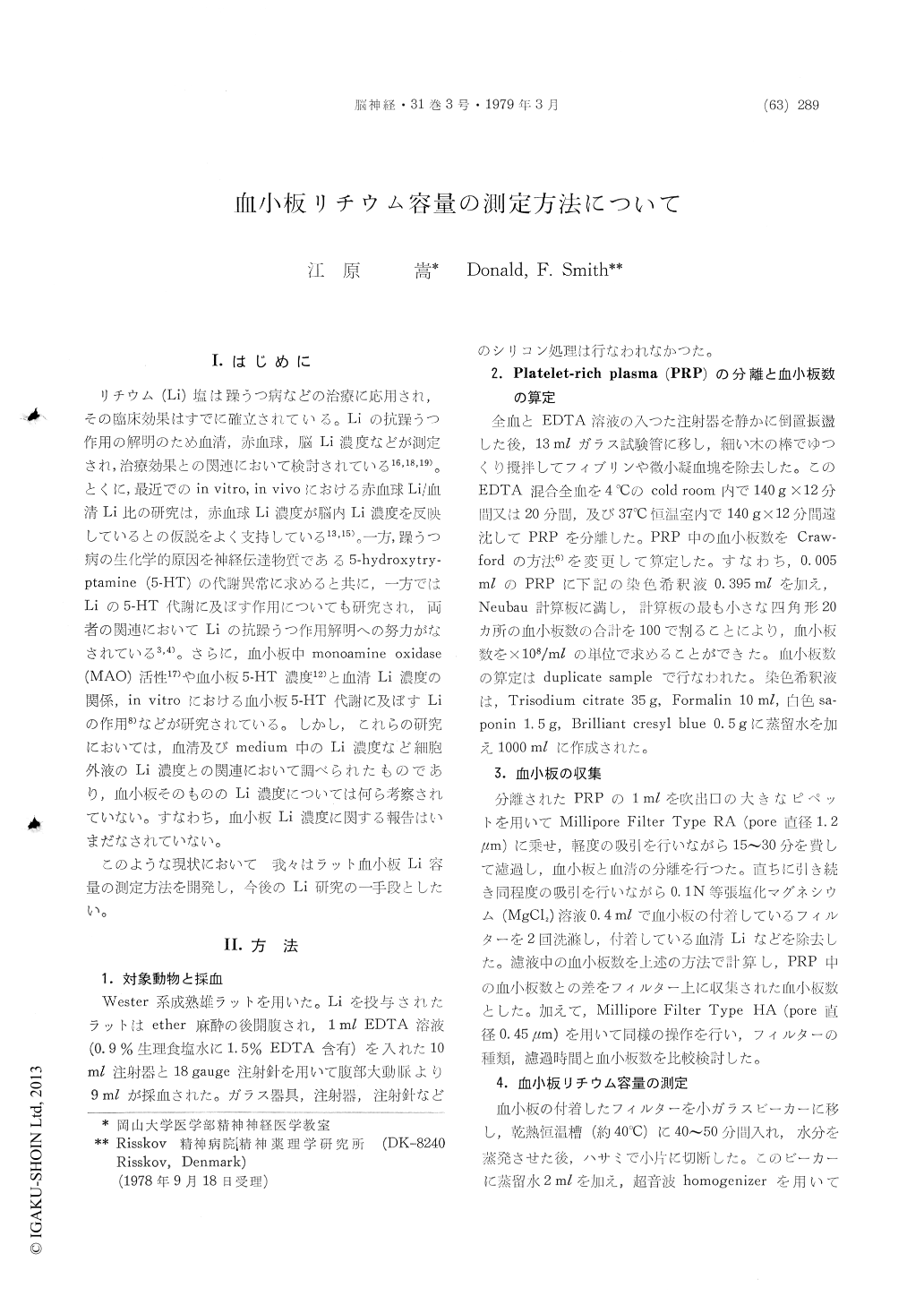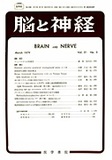Japanese
English
- 有料閲覧
- Abstract 文献概要
- 1ページ目 Look Inside
I.はじめに
リチウム(Li)塩は躁うつ病などの治療に応用され,その臨床効果はすでに確立されている。Liの抗躁うつ作用の解明のため血清,赤血球,脳Li濃度などが測定され,治療効果との関連において検討されている16,18,19)。とくに,最近でのin vitro,in vivoにおける赤血球Li/血清Li比の研究は,赤血球Li濃度が脳内Li濃度を反映しているとの仮説をよく支持している13,15)。一方,躁うつ病の生化学的原因を神経伝達物質である5—hydroxytry—ptamine (5—HT)の代謝異常に求めると共に,一方ではLiの5—HT代謝に及ぼす作用についても研究され,両者の関連においてLiの抗躁うつ作用解明への努力がなされている3,4)。さらに,血小板中monoamine oxidase(MAO)活性17)や血小板5—HT濃度12)と血清Li濃度の関係,in vitroにおける血小板5—HT代謝に及ぼすLiの作用8)などが研究されている。しかし,これらの研究においては,血清及びmedium中のLi濃度など細胞外液のLi濃度との関連において調べられたものであり,血小板そのもののLi濃度については何ら考察されていない。すなわち,血小仮Li濃度に関する報告はいまだなされていない。
このような現状において 我々はラット血小板Li容量の測定方法を開発し,今後のLi研究の一手段としたい。
Studies on blood platelets are often used in re-search on the biological pathogenesis of psychosis and the mode of action of the lithium ion (Li), because the blood platelets is binding 5-hydroxy-tryptamine (5HT) and having the 5HT metabolism in itself. A shortcoming of the studies on blood platelets has been, however, that the effects of Li were related only to the extracellular concentration of Li rather than to the content of Li in the blood platelets.
A method for determination of Li content in blood platelets was descrived in this paper. First, 9 ml of whole blood was drawn into nonsiliconized, EDTA (1 ml) treated glass tubes from rats under ether anesthesia. Second, the blood samples was centrifuged for 12 min at 140 g in cold room (4℃) to provide at least 1 ml of platelet-rich plasma (PRP). Third, the number of platelets in PRP was counted using the method of color-dilution. Forth, the 1 ml of PRP was passed through Millipore Filter Type RA with a pore diameter of 1.2 μm to separate plasma from platelets. Fifth, the number of platelets in the filtrate was counted in order to caluclate the number of platelets on the filter. Sixth, the platelets on the filter were washed with isotonic MgCl2 solution (2 m/) to remove Li from the extrocellular medium. Seventh, the platelets on the filter were sonicated in 2 ml of distilled water to release Li from platelets into the medium. Finally, the Li concentration in the medium was determinated by atomic absorption spectrophotometry and the Li content in the blood platelets was calculated on the unit of nEq/108 platelets.
Various centrifuging conditions, e. g. the force, the temperature and the time lenght of centrifu-gation, were compered in order to obtain the highest number of platelets in PRP, and, in adition, type of Millipore Filter to separate the platelets from PRP was discussed.
In in vitro studies, PRP was incubated with 1 mEq/l Li in the artificial serum for 1, 3 or 5 min. The Li uptake into platelets was significantly in-creasing in these incubation period. In in vivo studies, the Li content in blood platelets in rats given the various amount of isotonic LiCl solution (2.0, 3.0 or 4.0 mEq/kg/day) by gastric load for 3-4 days increased significantly as the daylly dose of Li increased.
These evidences on in vitro and in vivo studies indicated that the Li content in the blood platelets was able to determine using this method.
Although the present method was worked out using rat, preliminary studies show that the method can also be used to determine the Li content in human blood platelets and that the method may be used in future studies on the effects of Li on human and animal platelets.

Copyright © 1979, Igaku-Shoin Ltd. All rights reserved.


